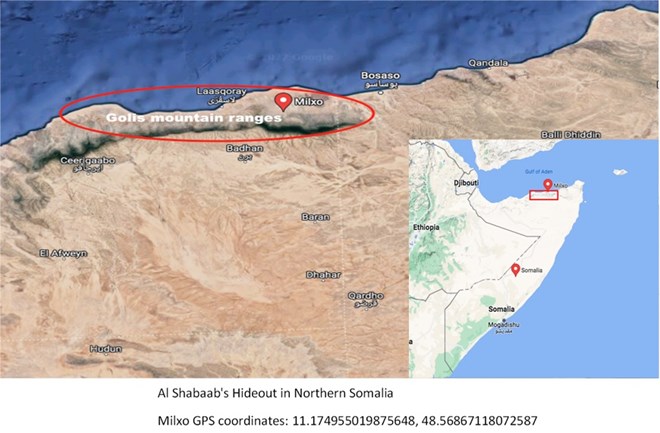Saturday November 19, 2022
By Abdirisak Abdulkadir Ibrahim

As Al-Shabaab and Islamic State expand in Somalia, a
growing artisanal gold mining practice has become a key target for their
Zakaawat (taxation) operations in Northeastern Somalia. Thousands of Artisanal
miners in the Golis mountains population center of Milxo have become their
target for a new revenue stream, creating armed conflict in the area. Since
early 2008, the Golis mountain ranges have been an area of insurgency featuring
the Puntland State Government of Somalia and the Al Qaeda affiliate, Harakatul
Shabaab Mujahideen (HSM), commonly known as Al-Shabaab.
A poor region of mainly nomadic pastoralists and
frankincense harvesters, Golis mountains has in recent years become the focus
of an insurgency by Al-Shabaab, counter-insurgency by Puntland armed forces,
and vigilante uprisings by clan militia against the Al-Shabaab. The violence
has killed scores of people, including gold mine workers, Al-Shabaab militants,
and even Puntland security forces members.
One reason is that gold was found in the mountain ranges
near Milxo, a village located 60 km away from Las Khoray town in Puntland's
Sanaag region. Originally established as a seasonal pastoral settlement, the discovery
of gold in the area attracted over 5,000 new families, turning the once sleepy
village into a bustling small town of commercial activity.
7,000 people are estimated to live in the town, who work
primarily in mining and other aspects of the gold economy.
Gold Mining in Milxo
Mainly, there are two types of gold mining practices in
Milxo village
1. Surface (Opencast) mining: This is a process by which women and children
go out to look for gold nuggets found at the ground surface or in alluvial
deposits. In this type, they don't dig up anything but sometimes do basic
panning to separate gold from sand. They sometimes crush quartz crystals with
gold veins and separate quartz from the gold.
2. Deep Cast: This is a process by which basic unskilled
miners use manually driven hand tools to dig deep pits ranging from 5-20 meters
to retrieve gold ore. The gold ore is then transported and refined at a mill
operated by a refiner/smelter who earns a percentage of the gold output for
their services and has the right to purchase the rest of the gold yield from
the miners.
We found that none of the miners had valid permits from
the state government.
The mining process presents several workplace health and
safety challenges to the miners. They work without engineers who could help
them plan safe operations using rudimentary hand tools to dig the gold pits.
They need safety and personal protective equipment to protect themselves from
mining-related hazards.
"Accidents,
especially cave-ins, are common in the mines," said Omar, a gold miner.
"There aren't any health facilities in Milxo, and miners must transport
injured coworkers on poor roads to the closest health facility in Bossaso."

Gold Output in the Milxo Area
It is hard to say how much gold the mines produce since
the mining operations have stayed largely beyond the control of the government,
and there needs to be more statistics on gold output and export from the Milxo
area mines. Most of the mines are located where the government forces are
absent, and the elusive Al-Shabaab militia roams.
However, a focus group discussion we held with miners and
traders in the area suggested that gold mines within the vicinity of Milxo
produce an estimated 300 kg of gold, worth 1.5 million USD, annually.
According to the miners, most of the Golis mountain's
informally produced gold is smuggled to the UAE black market from nondescript
ports to avoid multiple export taxes from the Al-Shabaab and the Puntland
government. The gold is refined and melted into bars in Puntland before
smuggling to the UAE.
Al-Shabaab campaign for command and control in Milxo
Besides attacking military and government targets within
the mountain ranges and in the port city of Bossaso, Al-Shabaab has been
campaigning to collect revenues from the million-dollar artisanal gold trade in
the Milxo area.
"In
2019, they started with community mobilization campaigns in Milxo village,
trying to canvas support for Al-Shabaab administration and control of the
mining operations," Mohamed
Haji Abdi, a resident of Milxo a local resident told us, "the elders refused to collaborate with them in
matters concerning the administration and control of the mining operations."
According to a former SNA Sector 54 officer, Al-Shabaab
resorted to aggressive military action after this rejection.
"After
talks with the community failed, Al-Shabaab launched a military campaign. It
was characterized by reinforcement of HUMINT operations, the establishment of
strategic forward operating bases in mountainous locations surrounding the
village and attacking and occupying Milxo village to impose their will on
several occasions," Ex-Major
Abdirahman, a former senior officer who served in the Golis mountains with Army
sector 54 HQ.
The ex-major also explained that the militants' advance
in Milxo has been complicated, carried out by highly mobile groups with bases
in the neighbouring villages. The reported attacks have focused on Milxo
village and extend towards 50 small-scale mines in the Milxo area and the
village center.
The Al-Shabaab units operating in the artisanal gold
mining area are highly mobile, dismounted, and heavily armed. Moving on foot
and carrying their supplies on donkeys, the armed Al-Shabaab militia has managed
to establish a taxation scheme on the gold mining in the area, despite the
considerable presence of Puntland and international counter-terrorism troops in
and around the Golis mountain ranges.
Al-Shabaab Zakaawat (Tax) Operations in Milxo
A sub-unit of the Al-Shabaab, Zakaawat department is
highly mobile and pays irregular visits to field sites to collect taxes from
all entities involved in the artisanal gold economy in Milxo village. This unit
is provided human intelligence by clandestine Al-Shabaab HUMINT personnel,
mostly embedded covertly at all levels of the town's gold mining and trade. To
enforce their extortion policy, Al-Shabaab has heavily armed units in
mountainous villages and outposts surrounding the gold mines along important
supply and transportation routes supporting life in the Milxo.
Using coercion and extortion, Al-Shabaab has exploited
the gold mining in Milxo. Al-Shabaab conducts direct mining activities and has
about 100 miners working clandestinely in the area. This group is also the core
of their human intelligence network, which provides information on mining
activities to their tax collection units.
They generate revenue from taxing gold ore output in the
area. The ore prices have a high-end price of $35 USD/kg. Al-Shabaab levies 30%
of the selling price on the miner or ore seller; gold ore buyers are also taxed
40% of the cost price on all the ore purchases made by the refiners. We
couldn't find out the amounts that Al-Shabaab makes from this annually.
Future Outlook of the Matter
Gold has always been a companion of insurgents, prized
for its never-ending demand and value in the global marketplace.
For Al-Shabaab, the gold mines are a new revenue stream
conveniently located in their area of operation. This viable cash cow enables
them to sustain their existing militia, fund new recruitment and purchase arms,
explosives, and detonation devices to conduct IED operations.
Al-Shabaab has demonstrated the capability to command,
control, and conduct maneuvers in the Milxo area with ease and impunity, thanks
to;
a) The rough terrains in their chosen area of operation
b) The financial, logistical, technological, and human
resources limitations facing the Puntland government and its international
partners
c) Confrontations between Puntland and Somaliland in the
Sanaag region, especially along their territorial boundary in the Golis
mountains
d) Limited institutional capability to regulate and
control gold mining and illegal exports, as well as the prevalence of huge
market demand for gold in the UAE black market
e) An ungoverned porous maritime border easily accessible
from the mountains.
If left unchecked, the illicit financial flows from the
Milxo gold mines will provide the Al-Shabaab with immense capabilities. It
would provide the financial resource that will enable them to capture more land
territory and eventually develop seagoing capabilities, bringing terror to the
high seas and disrupting international maritime traffic travelling through the Bab-el-Mandeb and the Gulf of Aden maritime routes.
---
Abdirisak
Abdulkadir Ibrahim
[email protected]
Abdirisak is a Research Associate at the Horn
International Institute for Strategic Studies, specializing in governance, security,
conflict resolution and peace processes in East Africa region.